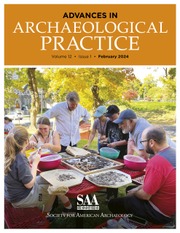No CrossRef data available.
Article contents
Testing of Shoreline Erosion Monitoring Methodologies for Heritage at Risk Sites: Pockoy Island, South Carolina, USA
Published online by Cambridge University Press: 08 November 2024
Abstract
We review shoreline monitoring methodologies used by members of the South Carolina Department of Natural Resources (SCDNR) Archaeology, Geology, and Wildlife Biology teams from February 2021 to December 2022 on Pockoy Island in Charleston County, South Carolina, USA. Our project objectives were to better understand the driving forces behind the landward movement of the shoreline (transgression), to apply new understanding to the rate of shoreline erosion of the island that directly impacts the Pockoy Island Shell Ring Complex (38CH2533), and to establish best practice for future community science monitoring efforts. Each member of our team used a different shoreline monitoring methodology (a nested methodology approach). Multiple unoccupied aerial vehicle (UAV)-derived orthoimagery datasets, on-the-ground transect measurements, and Arrow Gold real-time kinematic (RTK) unit measurements have been collected monthly following significant storms or king (perigean) tide events. Moving forward, the erosion transect approach tested within this project will serve as the foundation for community science monitoring at heritage at-risk sites in South Carolina. In this article, we introduce initial efforts in establishing a community science monitoring program in South Carolina that will influence future research, land management, and policy, and we propose how our research might be adapted for other sites at risk.
Resumen
Nosotros revisamos métodos de monitoreo de la línea costera usadas por miembros de equipos de arqueología, geología, y biología de la vida silvestre del Departamento de Recursos Naturales de Carolina del Sur desde febrero 2021-diciembre 2022 en la isla de Pockoy en el condado de Charleston, Carolina del Sur, Estados Unidos. Los objetivos de nuestro proyecto fueran comprender las causas primarias del movimiento de la costa hacia la tierra, aplicar comprensión nueva sobre la velocidad a la que se pierde la tierra de la isla que impacta el sitio que lleva por nombre Pockoy Island Shell Ring Complex (38CH2533), y establecer mejores prácticas para futuros esfuerzos de monitoreo científico por parte de la comunidad. Cada miembro del equipo usó una metodología diferente (un enfoque de metodologías anidadas). Múltiples conjuntos de datos de orto-imágenes recogidos por vehículo aéreo desocupado (UAV), medidas de transecto, y medidas de Arrow Gold real-time kinematic (RTK) han sido coleccionados cada mes después de tormentas fuertes o mareas reales (mareas del perigeo). Pensando en el futuro, las medidas de transecto investigadas por este proyecto serán la fundación para un monitoreo científico por parte de la comunidad en los lugares de patrimonio en riesgo de Carolina del Sur. En este documento, nosotros introducimos los primeros esfuerzos para establecer un programa de monitoreo científico por parte de la comunidad en Carolina del Sur que influirá futuras investigaciones, gestión de tierras, y póliza; y proponemos cómo nuestro estudio puede ser aplicado a otros lugares en riesgo.
Keywords
- Type
- How to Series
- Information
- Advances in Archaeological Practice , Volume 12 , Special Issue 3: Monitoring Heritage at Risk Sites in Rapidly Changing Coastal Environments , August 2024 , pp. 276 - 288
- Copyright
- Copyright © The Author(s), 2024. Published by Cambridge University Press on behalf of Society for American Archaeology


